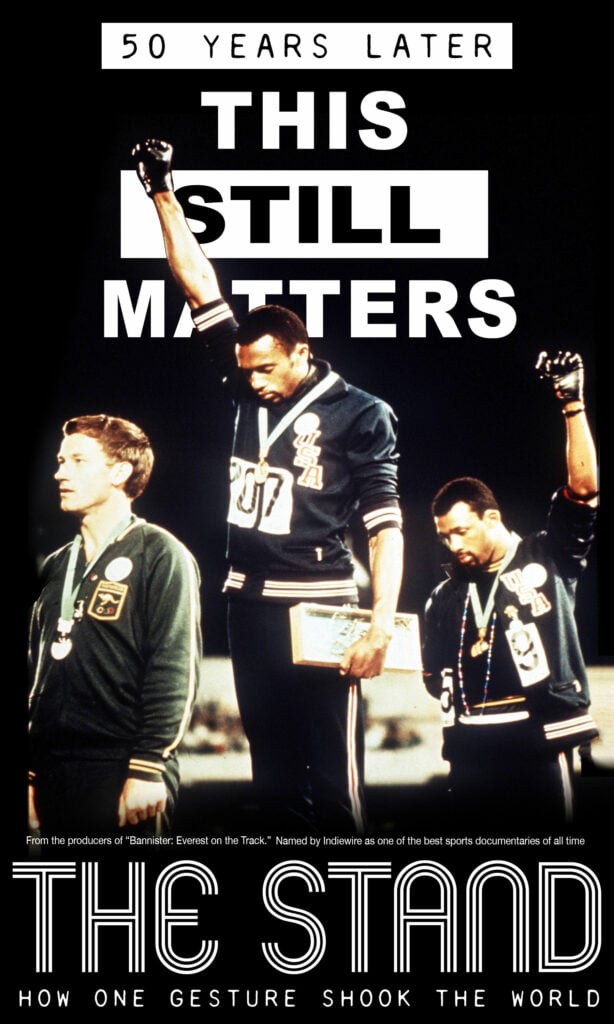The Stand: 52 Years Later, Tommie Smith & John Carlos’ Famous Protest Is As Relevant As Ever
By Jonathan Gault
August 4, 2020
When Tom Ratcliffe and Becky Paige were looking for their next film project in 2015, they wanted to focus on a historically significant event in track & field, similar to Roger Bannister‘s breaking of the sub-4:00 mile barrier, the subject of their terrific first film together, Bannister: Everest on the Track. They landed on Tommie Smith and John Carlos‘ Black Power salute on the 200-meter podium at the 1968 Summer Olympics. It was a powerful moment, the 50th anniversary was approaching, and while the image of Smith and Carlos on the podium is instantly recognizable, Ratcliffe and Paige felt the definitive story had yet to be told in the manner it deserved.
 The result was The Stand, which Ratcliffe and Paige, who co-directed the film, first screened in 2018. At the time, however, Ratcliffe, who also served as producer, struggled to find a wider release.
The result was The Stand, which Ratcliffe and Paige, who co-directed the film, first screened in 2018. At the time, however, Ratcliffe, who also served as producer, struggled to find a wider release.
“Those decision-makers were, I think, concerned that it was a bit controversial,” says Ratcliffe, who is also the agent of several top American distance runners, including Evan Jager, Lopez Lomong, and Courtney Frerichs. “I was a bit surprised, because I don’t think there’s anything controversial in it. It’s basically people giving their opinions. You don’t have to agree.”
That concern has dissipated amid the tumult of 2020. The killings of Ahmaud Arbery, Breonna Taylor, and George Floyd reignited the Black Lives Matter movement and sparked protests across the country and a national conversation on equality and race — the same conversation Smith and Carlos drew attention to through their raised fists in Mexico City. As the 2021 Tokyo Olympics approach and athletes debate about how and whether to protest on the podium, Smith and Carlos are as relevant now as they were 52 years ago.
Eventually, the streaming companies caught on: beginning today, The Stand can now be viewed on iTunes, Amazon, and Google Play, among several other options.
It’s worth the watch. While the entire film is, nominally, about “The Stand,” the segment dedicated to the gesture itself runs just seven of the film’s 69 minutes. Which makes sense when you consider the medal ceremony lasted less than two minutes and the protest itself had only been planned shortly beforehand, after the 200m final had taken place earlier that day.
The true value of the film, instead, is its ability to place that moment on the podium into context (some of that context: Smith says his gesture was not meant to demonstrate Black Power, but rather “solidarity and strength”). While Carlos did not sit for an interview (the film instead draws upon a 2013 Library of Congress interview), Smith offers compelling insights, notably into his mindset between the semifinal — in which he strained his groin crossing the finish line — and the final later that day, in which he won gold. Even half a century on, Smith’s memory remains fresh, the uncertainty around his groin still managing to lend an element of drama even though we all know the outcome.
We also learn about the Olympic Project for Human Rights (OPHR), the organization established by activist Harry Edwards in the run-up to the Games (Smith and Carlos were both part of it) to protest racism. While the OPHR’s proposed boycott of the 1968 Olympics fell flat, it planted the seeds for Smith and Carlos’ famous gesture and earned support from their fellow Olympians, even if that support was not widely publicized at the time. The Harvard men’s crew team — which was selected as the US’s entry in the coxed eight rowing competition in Mexico City — met with Edwards before the Games, with several members endorsing OPHR. One of them, Paul Hoffman, was in the stadium for the 200m medal ceremony and gave his OPHR pin to the silver medalist, Peter Norman of Australia, who donned it on his tracksuit in support of his American podium mates.
“The public was definitely against them and felt like they had dishonored the country — and that was [IOC president] Avery Brundage leading the way,” Ratcliffe says. “But I think there were a lot of people that were supportive of them.”
Racial inequality — the reason for Smith and Carlos’ protest 52 years ago — is still an issue in the United States of 2020, yet Smith remains optimistic. Expelled from the Games, castigated by the media for his actions, and facing death threats and economic hardship upon his return to the US, it would have been easy for Smith to become disillusioned in his country. But it hasn’t happened.
“He wasn’t bitter,” Ratcliffe says. “He definitely thought we could do better. But as we present in the film, he went through a lot — he went through much more than we were able to include — and continued to believe in this country and the ideals of this country. I was pleasantly surprised by that.”
Trailer for The Stand







